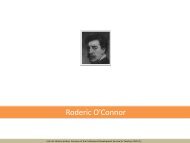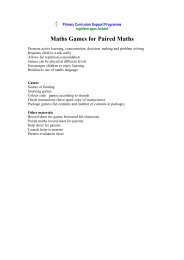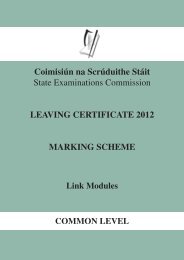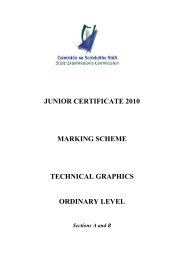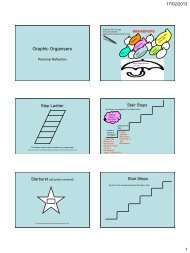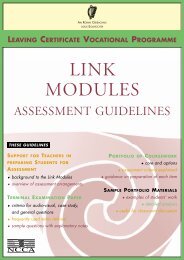GUIDELINES FOR TEACHERS - Curriculum Online
GUIDELINES FOR TEACHERS - Curriculum Online
GUIDELINES FOR TEACHERS - Curriculum Online
You also want an ePaper? Increase the reach of your titles
YUMPU automatically turns print PDFs into web optimized ePapers that Google loves.
PHYSICS<br />
5.4 WORKED PROBLEMS<br />
Suitable problems are provided in the student materials.<br />
The problems and their solutions are provided in this<br />
section. These worked problems relate to the syllabus<br />
sections in particle physics, as follows:<br />
2<br />
You<br />
wish to design a scale model of the hydrogen<br />
atom. The nucleus is to be represented by a marble<br />
with a diameter of 1 cm. What would be the diameter<br />
of the orbit of the electron<br />
background calculations of sizes and magnitudes<br />
questions 1, 2 ,and 3<br />
radius of proton, r = 0.85 × 10 –15 m<br />
radius of smallest orbit of electron, R = 5.29 × 10 –11 m<br />
conservation of energy and momentum in nuclear<br />
reactions<br />
question 4<br />
Answer<br />
R<br />
r<br />
=<br />
model diameter<br />
marble diameter<br />
1<br />
Imagine<br />
acceleration of protons<br />
question 5<br />
converting mass into other forms of energy<br />
question 6, 7, and 8 (also question 4)<br />
families of particles<br />
question 9 (also question 7)<br />
quark model<br />
question 10<br />
that a molecule of water occupies a volume<br />
that can be approximated to a sphere of diameter<br />
2 × 10 –10 m.<br />
3<br />
The<br />
R<br />
r<br />
= 5.29 × 10 –11 /0.85 × 10 –15 = 6.22 × 10 4<br />
Model diameter = 6.22 × 10 4 cm = 622 m<br />
rest mass of an electron is 9.1 ×10 –31 kg.<br />
(a) What is the rest mass in joules<br />
(b) What is the rest mass in mega-electronvolts<br />
Answer<br />
(a) Rest energy: mc 2 = 9.1 × 10 –31 × (3 × 10 8 ) 2<br />
(b) 1 eV<br />
= 1.60 × 10 –19 J<br />
= 81.9 × 10 –15 J<br />
1 MeV = 1.60 × 10 –19 × 10 6 = 1.60 × 10 –13 J<br />
(a)<br />
(b)<br />
Answer<br />
(a)<br />
How many such spheres laid out end to end<br />
would make a chain of 1 cm in length<br />
Approximately how many such spheres would<br />
make up a volume of 1 cm 3 <br />
2 × 10 –10 m = 2 × 10 –8 cm<br />
4<br />
Helium<br />
me = 8.19 × 10 –14 /1.60 × 10 –13<br />
= 0.511 MeV<br />
is created in the sun by the fusion reaction<br />
2<br />
H + 2 H → 3 He + n<br />
1 1 2<br />
1 ÷ (2 × 10 –8 ) = 0.5 × 10 8 = 5 × 10 7<br />
How much energy is released<br />
1 cm contains 5 × 10 7 molecules<br />
(b) 1 cm 3 contains (5 × 10 7 ) 3 = 125 × 10 21<br />
= 1.25 × 10 23 molecules.<br />
Note: This shows that a teaspoon (5 cm 3 )<br />
contains 6.25 × 10 23 molecules, i.e.<br />
approximately Avogadro’s number of<br />
molecules.<br />
How is the energy divided between the products<br />
in the reaction<br />
Rest energies<br />
1 u = 931.5 MeV<br />
n: 1.00899 u<br />
d: 2.01474 u<br />
He: 3.01698 u<br />
Answer<br />
2 × 2.01474 = 4.02948<br />
1.00899 + 3.01698 = 4.02597<br />
Energy released = 0.00351 u = 3.27 MeV<br />
35



